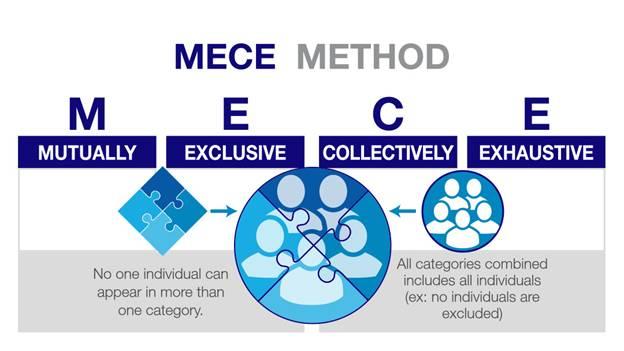Understanding the significance of code optimization is like realizing the power of tidying up your living space. Just as a well-organized home makes daily life smoother, optimized code streamlines the operation of your software. It's all about making your program run faster and more efficiently while using fewer resources.
Think of it as decluttering lines of code, removing redundancies, and finding smarter ways to solve problems. The result? Improved user experiences, reduced operating costs, and a more competitive edge in the world of software development. So, dive into the world of code optimization; your software—and your users—will thank you for it.
The MECE Framework in Code Optimization
The MECE (Mutually Exclusive, Collectively Exhaustive) Framework is like the secret sauce in the recipe for successful code optimization. Imagine you're organizing a collection of diverse puzzle pieces. Each piece represents an aspect of your code, and the MECE Framework helps you sort them into distinct categories that don't overlap (Mutually Exclusive) and ensure you've covered everything (Collectively Exhaustive).

This approach is invaluable in code optimization because it helps you break down complex tasks into manageable pieces, ensuring that no critical optimization opportunity is missed. Just as a well-organized puzzle can be completed with ease, the MECE Framework simplifies the process of achieving peak performance in your code.
The Fundamentals of Code Optimization
What is Code Optimization?
Code optimization is like giving your software a turbo boost. It's the process of fine-tuning your code to make it run faster, use fewer resources, and perform more efficiently. Imagine your code as a car engine; code optimization is like upgrading it to a high-performance engine that sprints without wasting fuel. It involves various techniques, from simplifying complex algorithms to minimizing redundant operations.
In the world of software development, where speed and efficiency are paramount, mastering code optimization can be a game-changer. It not only enhances the user experience but also saves valuable resources, making your software a top contender in the race of digital performance.
Why Code Optimization Matters
Code optimization matters because it's the secret sauce that transforms sluggish software into a blazing-fast masterpiece. Imagine waiting for a webpage to load, and it takes forever – that's the pain code optimization solves. It's all about making software run smoother, quicker, and with fewer hiccups. When your code is optimized, it's like having a well-oiled machine that works effortlessly, delivering a seamless user experience.
Plus, it's eco-friendly, reducing the unnecessary consumption of computing resources. In a world where speed, efficiency, and user satisfaction are gold, code optimization is your golden ticket to software success.
Identifying Performance Bottlenecks
Profiling Your Code
Profiling your code is like putting on a detective's hat in the world of code optimization. It's all about finding the culprits that slow down your software. By analyzing the performance of your code, you can pinpoint bottlenecks and areas that need improvement.
This detective work is crucial because it saves time, money, and resources in the long run. It helps you focus your efforts on the parts of the code that matter most, ensuring that your software runs at peak performance. So, if you want to be a code optimization hero, profiling is your trusty sidekick, guiding you to a smoother, faster, and more efficient software experience.
Common Performance Issues
In the world of code optimization, there are some common performance issues that developers often encounter. These issues can slow down your software and make it less efficient. One of the most common culprits is inefficient algorithms, which can lead to longer execution times. Another issue is excessive memory usage, where your code consumes more memory than necessary, causing slowdowns and potential crashes.
Additionally, poor database design can also hamper performance, as it leads to slow data retrieval and storage. Identifying and addressing these common performance issues is essential for achieving optimal code efficiency and ensuring that your software runs smoothly.
Best Practices for Code Optimization
Utilizing Efficient Algorithms and Data Structures
In the realm of code optimization, one of the fundamental pillars is the utilization of efficient algorithms and data structures. By selecting the right algorithms and data structures for your specific task, you can significantly enhance the performance of your code.
Efficient algorithms execute tasks in less time, while well-suited data structures allow for streamlined data storage and retrieval. This optimization approach not only boosts speed but also conserves memory resources, making your software more efficient and responsive.
Minimizing I/O Operations
Minimizing Input/Output (I/O) operations is another key aspect of code optimization. Frequent I/O operations, such as reading from or writing to files or databases, can be resource-intensive and slow down your program. By reducing unnecessary I/O and optimizing the way data is read or written, you can decrease execution time and enhance overall performance.
This entails efficient buffering, batching, and caching strategies, ensuring that I/O operations occur only when essential.
Reducing CPU and Memory Usage
Code optimization strives to reduce both CPU and memory usage, vital resources for any software application. Optimized code minimizes CPU cycles by executing tasks more efficiently, which is crucial for enhancing responsiveness and energy efficiency.
Simultaneously, efficient memory management ensures that your program consumes less RAM, reducing the risk of slowdowns or crashes due to memory exhaustion. Striking the right balance between CPU and memory usage is essential for optimal performance.
Leveraging Parallelism and Concurrency
In the quest for code optimization, leveraging parallelism and concurrency is a powerful technique. Modern hardware often includes multiple processor cores, and optimizing your code to run tasks concurrently across these cores can result in substantial performance gains. Parallelism enables your software to process multiple tasks simultaneously, making the most of available resources and reducing execution time.
However, effective parallelism requires careful synchronization and coordination to avoid conflicts.
Profiling and Benchmarking
Profiling and benchmarking are indispensable tools in the arsenal of code optimization. Profiling involves analyzing your code's runtime behavior to identify bottlenecks and performance issues. Benchmarking, on the other hand, allows you to compare different implementations or optimizations to determine which one offers the best performance.
These techniques provide valuable insights into your code's strengths and weaknesses, guiding your optimization efforts toward the most impactful areas.
Effective Resource Management
Effective resource management is at the heart of code optimization. Whether it's handling file resources, memory, or network connections, efficient resource management ensures that your program allocates, utilizes, and deallocates resources optimally.
Poor resource management can lead to resource leaks, increased memory consumption, and decreased performance. By implementing robust resource management practices, you can significantly enhance the efficiency and reliability of your code.
The MECE Framework in Action
Mutually Exclusive Optimization Strategies
In the realm of code optimization, it's essential to consider mutually exclusive optimization strategies. These are approaches that, while effective individually, may conflict or overlap when implemented simultaneously. To maximize the benefits of code optimization, it's crucial to understand these strategies and choose the most suitable one for your specific scenario.
For example, optimizing for CPU usage and memory consumption can sometimes be at odds. A strategy that minimizes CPU cycles might require more memory, while one that conserves memory may use more CPU resources. Likewise, optimizing for single-threaded performance may not align with strategies focused on parallelism and concurrency, as these aim to distribute tasks across multiple threads or cores.
Another example involves trade-offs between speed and code readability. In some cases, optimizing for speed may involve complex and less readable code, while prioritizing readability may result in slightly slower execution. Balancing these considerations is essential to strike the right optimization balance for your project.
By recognizing these mutually exclusive optimization strategies and carefully evaluating their implications, you can make informed decisions that align with your project's goals and constraints. Ultimately, effective code optimization involves finding the optimal trade-offs that deliver the desired performance improvements without introducing unnecessary complexity or conflicts.
Collectively Exhaustive Solutions
In the context of the MECE (Mutually Exclusive, Collectively Exhaustive) framework, achieving collectively exhaustive solutions is a crucial objective. Applying this framework to code optimization, means ensuring that your chosen strategies and approaches encompass all possible aspects of improvement in a comprehensive manner.
To break it down further, "mutually exclusive" implies that the optimization strategies you select should not overlap or duplicate efforts. Each chosen strategy should address a distinct area of improvement in your code. On the other hand, "collectively exhaustive" means that, together, these strategies should cover all aspects where optimization is needed.
For instance, if you're optimizing code for a software application, your chosen strategies should cover all potential performance bottlenecks, such as CPU usage, memory usage, I/O operations, and algorithmic efficiency. Each strategy should focus on a specific area, ensuring that no aspect of optimization is overlooked.
Achieving collectively exhaustive solutions in the MECE framework is about leaving no stone unturned when it comes to code optimization. It's a systematic approach that ensures you consider every possible angle for improvement, resulting in a well-rounded and highly optimized codebase.





